
<<
Back
East
College from its very construction has been surrounded by monuments
that have become dear to the hearts of generations of students.
Perhaps least known of them all is the first Boulder, a pink, colored
stone placed near the front of the building at its dedication in
1877 by the senior class of that year. Weighing 5,000 pounds and
bearing the class motto in Greek, "Andrizometha," or "Let
us be manly," it was procured from the property of Dr. A.C.
Stevenson, the first president of the board of trustees of Old Asbury.
When underclassmen attempted to bury the stone two nights before
the commencement exercises, the seniors who were guarding it drove
them off with stones, firing revolvers as the attackers fled, according
to a contemporary newspaper account. It remains today rather inconspicuous
beside East College,
its inscription barely legible.
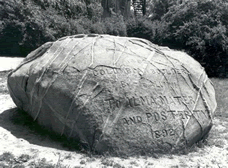 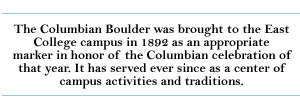
The better known Columbian Boulder was placed near the main entrance
to the building in 1892 at the instigation of former Professor John
C. Ridpath to mark the 400th anniversary of Columbus' first voyage
to the New World. This granite rock with prominent ridges of quartz
dykes was discovered near Morton about 12 miles northeast of Greencastle.
Hiram Thomas moved it to his farm, fenced it in and charged visitors
10 cents apiece to view the "petrified turtle." It was
purchased by a few alumni and brought to Greencastle by a 26-horse
house-moving wagon and the Monon Railroad. Inscribed and known as
the Columbian Boulder, it soon grew to be a favorite meeting place
on campus. Many a DePauw couple met for chapel dates "at the
Boulder." Honorary societies often held their initiation rituals
there, and it was long the scene of annual freshman-sophomore scraps.
In recent decades the Boulder seems to have lost its focal position
on campus, except for a brief period in the late 1960s and early
1970s when it became the scene of the "Boulder run," which
featured freshman pledges of Phi Kappa Psi scrambling around it
in the nude and trotting back to the chapter house on the night
of the first snow of the season.

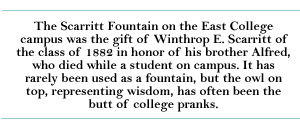
On the northern rim of the East
College lawn there stands a small stone pedestal which once
held a metal sun dial, now long missing. It was presumably placed
there around the turn of the century and is today generally overlooked
by all and sundry. Much more prominent is the Scarritt Memorial
Fountain, erected in 1903 as a gift from alumnus Winthrop E. Scarritt
in honor of his brother Alfred, who would have graduated in the
class of 1881 had he lived. Sitting atop the fountain, which has
lacked water for as long as anyone can remember, is a large bronze
owl - the symbol of wisdom. Frequently covered with splotches of
paint - as is the Columbian Boulder from time to time - the owl
was at one time reputed to hoot when a virgin passed by, but has
today lost most of its significance.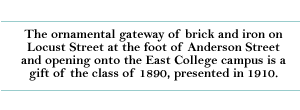 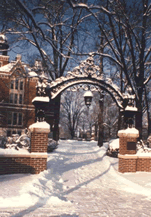
The most beautiful monument of all is the ornamental gateway constructed
of brick and iron located on Locust Street at the western end of
Anderson Street. The gift of the class of 1890 at their 20th reunion
in 1910, this gateway has long served as a major entrance to the
campus and familiar symbol of the university. Several concrete benches
donated by alumni, such as the recent one honoring Fred and Bernice
Tucker, lie scattered about the East
College lawn but have as yet gathered no special traditions
around them. New concrete sidewalks have replaced the originals
given by various college classes while the bronze plates with the
class numerals remain. The newest monument to grace the front of
East College is the
modernistic triangular metal shaft placed there in 1967 to memorialize
the founding of the journalistic honorary Sigma Delta Chi at DePauw
in 1909.
Back
to Top
<<
Back
|







